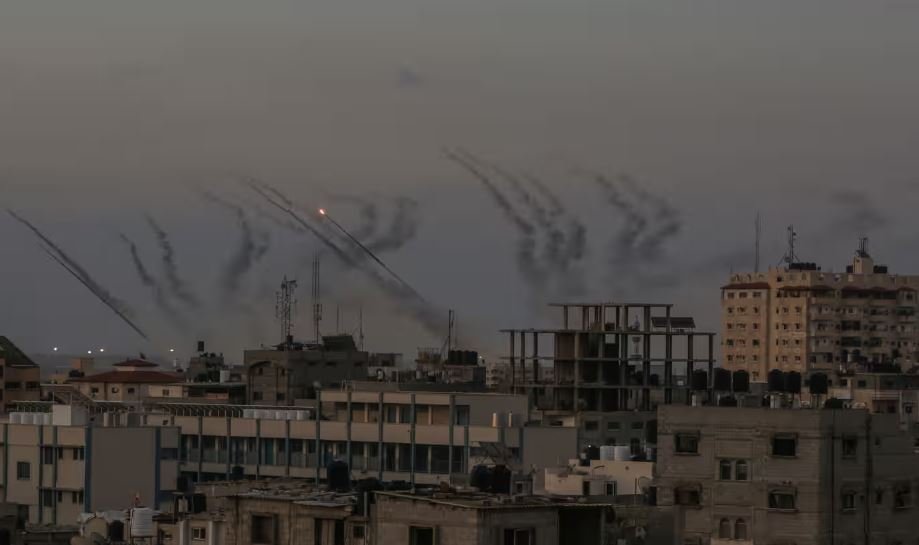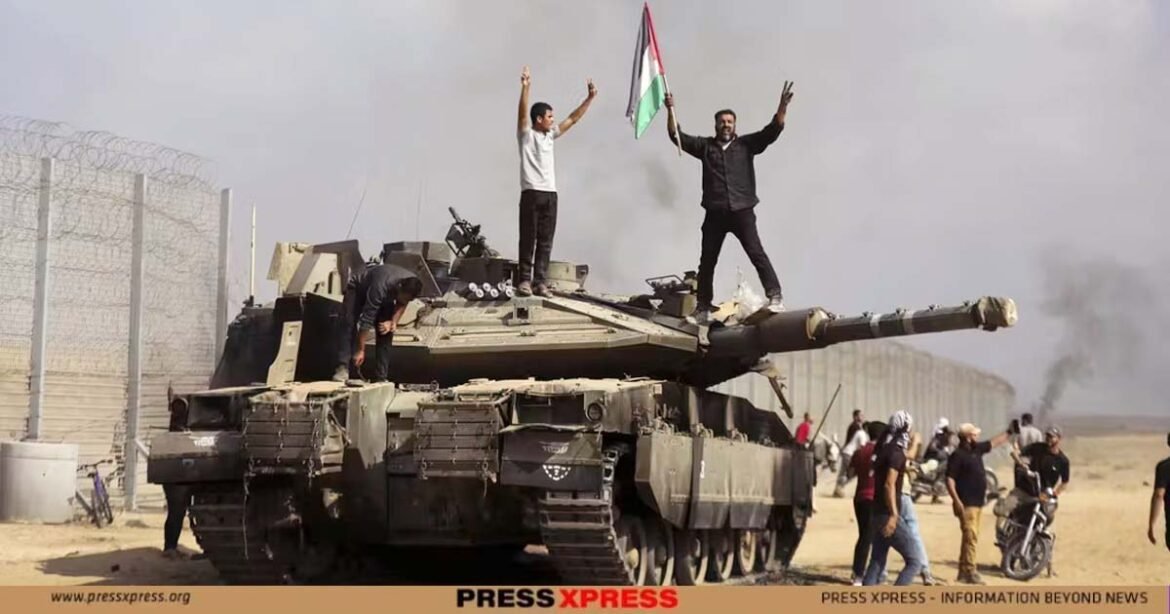In the early hours of Saturday morning, October 7, 2023, Palestinians launched a relentless assault on Israel from the Gaza Strip, unleashing a barrage of rocket attacks and daring fighters storming into Israeli communities. The conflict escalated dramatically as the day unfolded.
Hamas’s formidable military leader, Mohammad Deif, boldly claimed that a staggering 5,000 rockets had been fired at Israel, while the Israeli military asserted a lower number of 2,200. The relentless rocket fire persisted throughout the day, with evening sirens still blaring in the bustling city of Tel Aviv. To put this onslaught into perspective, it rivaled the 4,000 rockets fired by Palestinian resistance groups during the entire 50 days of the 2014 Gaza war.
In an audacious move, Palestinian fighters crossed from Gaza into Israeli territory. The exact count of those who infiltrated Israel remains uncertain, but it is believed to number at least dozens. Astonishingly, Hamas released footage depicting these fighters on motorbikes surging through a breach in Israel’s boundary fence. Reports even surfaced of paragliding Palestinian fighters soaring over the fence, opening gates for others to follow. Although unverified, purported online footage seemed to corroborate these accounts. Subsequently, Hamas released additional footage depicting their fighters utilizing paragliding equipment, although the timing of the recording remained ambiguous.

Death toll soars as conflict spirals out of control
Israel responded with substantial counterattacks in Gaza as the casualty count surged beyond 300. As of writing this report, according to local media, over 500 Israelis lost their lives, and 1,864 sustained injuries and on record, about 750 settlers are missing during the unexpected early morning assault, marking it as Israel’s deadliest incident in years. Furthermore, an undisclosed number of Israeli civilians and soldiers were seized and transported to Gaza.

In retaliation, Israel initiated its own response. The Palestinian Health Ministry reported that Israeli retaliation resulted in the deaths of 232 Palestinians and left at least 1,610 individuals wounded.
Political commentators, reflecting the sentiments of a nation in shock, levelled scathing critiques at the government and military. They bemoaned a glaring lapse in readiness, as the meticulously planned and seamlessly coordinated Hamas attack had caught Israel entirely off guard. It was an unprecedented and confounding breach in Israel’s formidable security apparatus, leaving the nation grappling with a sense of disbelief and uncertainty.
In this charged atmosphere, reporters asked Lt. Col. Richard Hecht, an Israeli army spokesman, an explanation for how Hamas had managed to spring such a surprising offensive. Confirming the extraordinary nature of this offensive, Israeli army spokesman Richard Hecht acknowledged it as a “combined ground raid, which occurred through paragliders, through the sea, and through the ground.”
Meanwhile, in the occupied West Bank and East Jerusalem, Palestinian medics documented the loss of three lives and over 30 injuries, including a heart-wrenching case of a 13-year-old boy caught in the crossfire.
Mohammed Deif’s call to action
In a recorded message from the elusive leader of Hamas’ military wing, Mohammed Deif, the motives behind the audacious assault emerged as a poignant litany of grievances:
- The enduring 16-year blockade of Gaza.
- Israeli military incursions deep into West Bank cities over the past year.
- The relentless violence that has marred Al Aqsa, the contested Jerusalem holy site, revered by Jews as the Temple Mount.
- The escalating attacks perpetrated by settlers upon Palestinians.
- The ceaseless expansion of Israeli settlements.
Hezbollah, the Lebanese armed movement, which had last clashed with Israel in 2006, celebrated the attack as a message that the Palestinian cause remained undying until victory and liberation.
In a shocking development, Hamas claimed to have taken numerous Israelis hostage, including both soldiers and civilians. Footages circulating online seemed to confirm that many hostages had been transported to Gaza.

As the day wore on, Israel acknowledged that fighting was still raging in 22 locations within its borders. Israeli army spokesperson Daniel Hagari disclosed the deployment of four divisions to the separation fence with Gaza, complementing the 31 battalions already stationed there. The climax of this volatile conflict was yet to be written, and the world watched with bated breath.
The striking timing of the Hamas incursion, occurring on Simchat Torah—a typically festive day when Jews conclude their annual cycle of reading the Torah scroll—evoked poignant memories of the 1973 Middle East war. Almost 50 years to the day, this war saw Egypt and Syria launch a surprise offensive on Yom Kippur, the holiest day in the Jewish calendar, with the aim of reclaiming Israeli-occupied territories.
The background: Echoes of 1973 war resurface
This audacious attack marks the most significant surprise assault on Israel since the 1973 war, launched by Egypt nearly 50 years ago. Both Hamas and Hezbollah have justified their actions as responses to Israeli transgressions at Al-Aqsa Mosque in occupied East Jerusalem.

In recent weeks, Israel has observed several major religious holidays, including Yom Kippur. Prior to Jewish prayers at the Western Wall, Israeli forces carried out raids on the adjacent Al-Aqsa Mosque, forcibly removing Palestinian worshippers. These provocations, reminiscent of 2021 when Israeli incursions into Al-Aqsa triggered a rocket barrage from Hamas, culminated in a two-week conflict resulting in the loss of 250 Palestinian lives and 14 Israeli casualties. It also ignited riots in mixed Palestinian-Jewish cities within Israel.
This year has been particularly grim for Palestinians in the occupied West Bank, marking the deadliest period since the Second Intifada ended in 2005. Israeli forces have claimed the lives of 172 Palestinians in the West Bank so far this year, while armed Palestinian resistance in the region has intensified.
It’s different this time
Ismail Haniyah, the political leader of Hamas, articulated the motives behind the attack, emphasizing that it served as retaliation for Israel’s ongoing assaults against Palestinians and its transgressions at Muslim holy sites, most notably the Al-Aqsa Mosque in occupied East Jerusalem.
With deep conviction, he stated:
“We had warned them repeatedly about the persistent and oppressive blockade imposed on Gaza, a place that has endured four or five wars, resulting in the loss of tens of thousands of lives, countless casualties, and the destruction of homes. Gaza finds itself ensnared in this tragic situation, trapped within a vast prison where two million people are compelled to rely on limited aid and occasional easing of the blockade to endure their hardships. It is as if they expect our people to silently accept this bitter reality, even as events of profound significance unfold in Jerusalem and Al-Aqsa.”
While residents of the Gaza Strip have tragically endured multiple Israeli attacks since the inception of the blockade in 2007, there is a prevailing sentiment that “this time it’s different.” Dina Basel, a resident of western Gaza City, shared her experience, recounting her swift evacuation from her home upon hearing of Palestinian armed factions launching rockets towards Israel.

Gaza’s skies fill with bombs
As the Israeli retaliation unfolded, a relentless deluge of bombs descended upon residential areas of the Gaza Strip, leaving devastation in its wake. This towering structure, comprising over 100 apartments, became a casualty of several Israeli fighter jets’ merciless bombardment.
The relentless onslaught extended to numerous other military and residential buildings across the Gaza Strip as part of Israel’s “Operation Iron Sword.” Among the targeted locations were the residence of Hamas leader Yahya al-Sinwar, the Charitable Institutions Building in Gaza’s southern region, and the al-Hashem building in the north, which housed a local NGO and 15 housing units.
The Norwegian Refugee Council reported that by February, 2023, nearly 2,000 homes in Gaza lay in ruins from past Israeli attacks over the past decade. The damage inflicted by Israeli strikes in 2021 and 2022 alone has left at least 100 families displaced in Gaza.
Israel has enforced a strict air, land, and sea blockade on the Gaza Strip since 2007, following the victory of the Hamas movement in legislative elections. Throughout this period, Israel has launched four major military assaults, inflicting severe damage on the strip’s infrastructure and causing the loss of hundreds of lives. The cycle of violence and suffering in this region has persisted for far too long.

De-escalation efforts may be influenced by several factors, including Western reluctance for another major conflict amid the ongoing war in Ukraine and the Biden administration’s diplomatic endeavors to secure a Saudi-Israeli normalization deal. The situation’s short and long-term evolution remains unclear, but as Masri emphasized, “What comes after October 7 will be different from what preceded it.” The conflict’s trajectory has been fundamentally altered, and the world watches with a mixture of apprehension and hope for a resolution to this enduring and devastating conflict.


